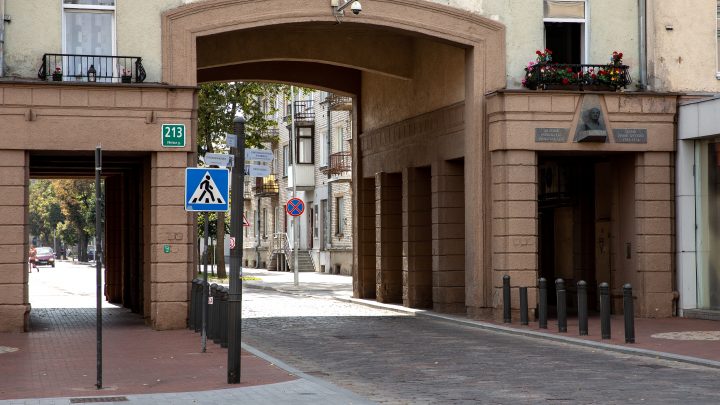Šiauliai streets tell their stories. Varpo Street
Varpo Street was marked as early as in the first city plan and formed the western boundary of the marketplace up to the current Vilniaus Street. In Šiauliai city plan of 1852, this street was extended beyond Vilniaus Street, towards the current Vytauto Street. At this place, the street was a bit wider and was a good place for a horse post office – horse-drawn carts. Until World War I, passengers were transported in horse-drawn stagecoaches covered with tin, with small windows. Goods were transported by a kind of long carts called balagulos, covered with white sheets or canvas. This means of transport was also often used by poor passengers.
The section of the street from the old market place towards Vilniaus Street was called Mokyklų Street (Školnaja ulica), while the other part that went downhill was called Sakalininkų Street (Sokolnickaja ulica). The street in the city plans of 1871 and 1902 has already one name – Nikolajaus Street (Nikolajevskaja ulica). Most probably, this was influenced by the stay of the Russian Tsar Nicholas I in Šiauliai in 1838.
During the years of World War I, Germans gave the street the name Turgaus (Markt Strasse). During this war, almost all buildings on the street burned down; after the war, the street was named Rinkos Street.
There were clothes and hat sewing shops; workshops of furniture, signage, musical instrument repair, tin processing; the cartridge case factory Ryga; shoemaker tools, leather, clothing, small haberdashery, meat, iron, clay pots, medicines, hops, flour, tobacco, glass and dishes were traded here.
In 1924, changing the names of the city’s streets, the street got the name Varpo. Before World War I, in the territory of the former central post office, the cultural organization Varpas Society had set up. In 1952, the street was renamed to Komunarų, and in 1989, the name Varpo was returned to it.
The Great Choral Synagogue
The decoration of Varpo Street was the Great Choral Synagogue. The city’s first wooden synagogue was built and opened on the site of the current drama theatre in 1749. According to the data of 1903, there were three masonry and eight wooden synagogues in Šiauliai. At the end of the 19 century, an impressive brick synagogue was built next to Market Square on what is now Varpo Street. Due to the graceful shapes of white plastered facades it was called the White Swan. Destroyed during World War I, the synagogue was rebuilt in the interwar period. It suffered greatly during World War II and was demolished after the war.
Theatre Poster Sufleris (Prompter)
It is built on Boulevard of Vilniaus Street near Varpo Street. Only a few steps from here stands the drama theatre.
Reminds of a double-sided notice-board. At the top, it is adorned by the mask of the patron of comedy Thalia on one side and by the mask of the patron of tragedy Melpomene on the other. The “prompter” himself, as befits him, is hiding from the audience. However, the most curious
can see him: all you have to do is take a look through the slit from the side what is under the prompter’s “shell” at the bottom of the notice board. On one side, the “prompter” is adorned with an earring in the ear; and on the other side, with an earring in the eyebrow.








Leave feedback